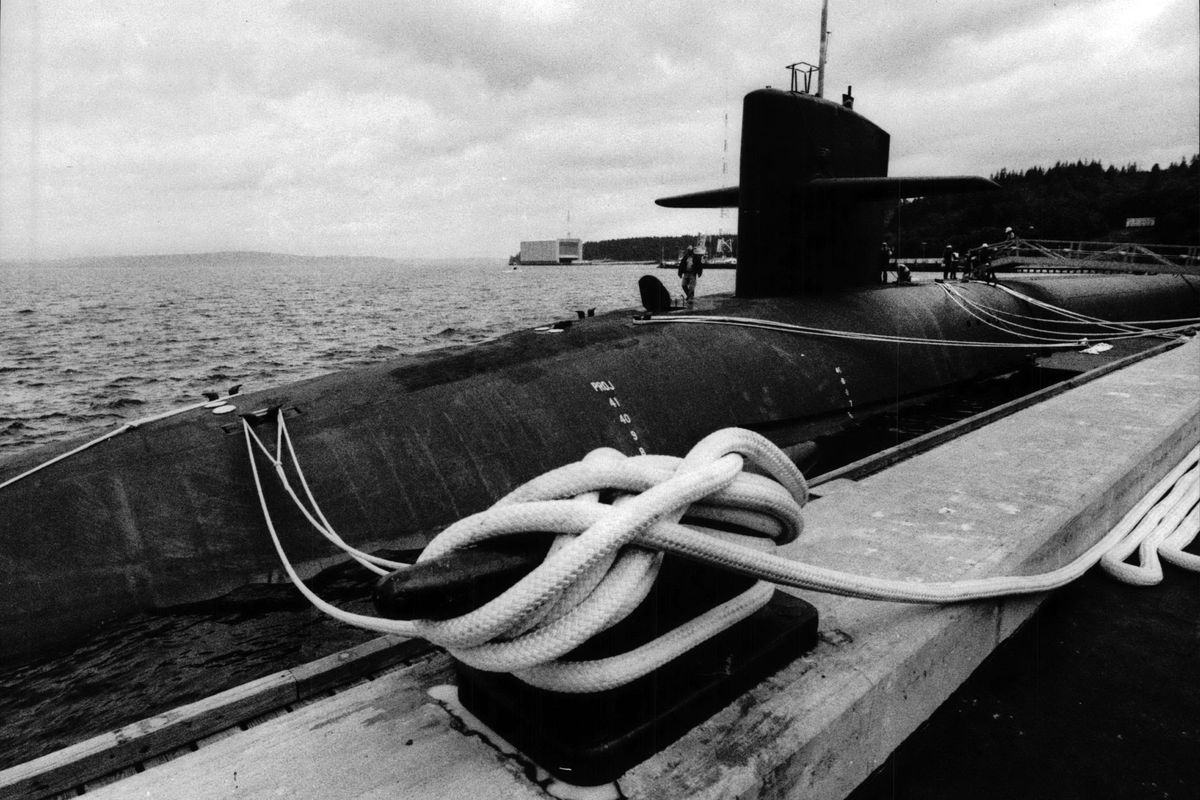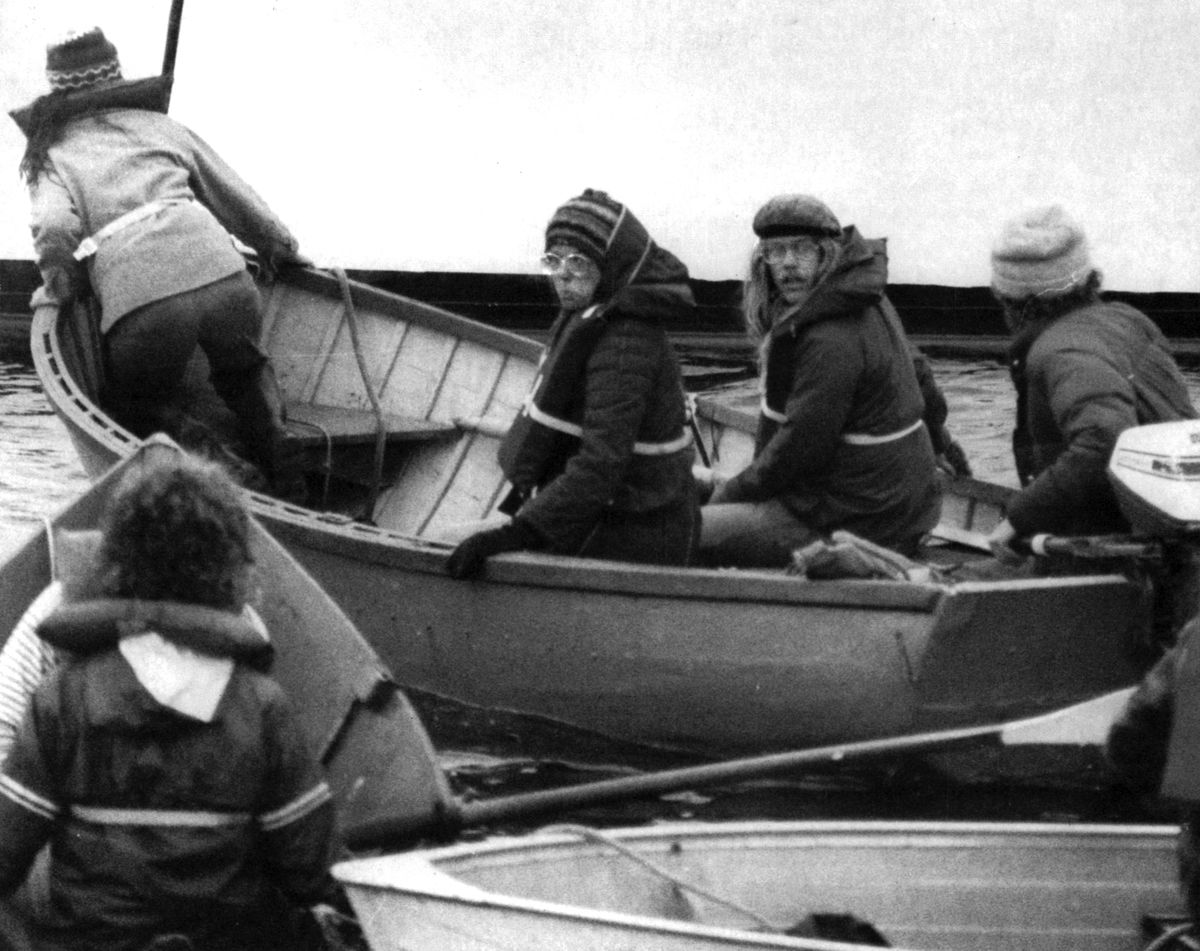Activists afloat attempted to stop nuclear submarine
Above: An activist protesting the USS Ohio is placed under arrest on a Coast Guard vessel in 1982. At left: The USS Ohio, the first nuclear Trident submarine, is seen in the Puget Sound in 1982.
The protesters were ready for a watery rendezvous with the huge vessel coming to the Northwest. They would take their boats out into Puget Sound and, like many Davids confronting an approaching Goliath, try to block the embodiment of the greatest danger they saw to continued life on the planet.
The Coast Guard warned them to stay clear of the path of the oncoming ship. But with news media – and, they said, the world – watching, when the word came they would get in their boats and try to stop it.
In this case, “it” wasn’t an Arctic oil drilling platform but the USS Ohio, the nation’s newest nuclear submarine.
A generation before “kayaktivists” paddled out into Elliott Bay to protest Shell Oil’s Polar Pioneer, another group of determined protesters rowed and motored their small crafts into a different part of Puget Sound intent on stopping the nation’s first Trident nuclear submarine on its way to its new home at Bangor Naval Station.
It was summer 1982. Ronald Reagan was presiding over a rapid buildup of the nation’s nuclear forces to up the ante with the Soviet Union.
The Ohio was the first Trident submarine, the newest – and arguably deadliest – weapon in the nation’s nuclear arsenal. A behemoth the length of nearly two football fields, when submerged it was said to be undetectable. It would cruise below the surface for three months at a time, then slip back into its home port to change out crews, restock food and supplies, and go out again.
It carried up to 24 intercontinental ballistic missiles, with each of those missiles having as many as eight independently targeted warheads holding an explosive force of 300 kilotons of TNT, or about 20 times the power of the bomb dropped on Hiroshima.
The nation had ordered 24, and the first was coming to a home in Washington state.
The call went out from Ground Zero and other peace groups, and in early August protesters came by the dozens to the shore along Oak Bay, about 20 miles south of Port Townsend and just north of Hood Canal, the waterway to Bangor.
Most were from the Seattle area but others from across the country and a few from as far as Australia, the home base of the Pacific Peacemaker, a 54-foot ketch that anti-war activists from that nation sailed to Puget Sound in time for the “blockade.” For several days, the Peacemaker and a trimaran from British Columbia, the Lizard of Woz, practiced towing smaller boats out into the inlet where they hoped to form a line that would force the Ohio to at least pause on its way to Bangor.
Seattle’s Catholic Archbishop Raymond Hunthausen, an outspoken critic of the nation’s nuclear buildup, visited the camp and blessed the boats.
The Coast Guard, too, practiced its maneuvers and told protesters they would not be allowed within 1,000 feet of the submarine when it arrived. Violating the restricted zone could mean a $10,000 fine and 10 years in prison.
A Soviet trawler, the Gavril Sarychev, dawdled in the Strait of Juan de Fuca most of the summer, ostensibly fishing but reportedly listening for some sonar pattern that would help its military track the elusive sub. A U.S. Navy destroyer kept watch on the Soviet watchers.
Kitsap-area residents who supported the Trident and the Bangor base protested the protesters, hanging “Welcome USS Ohio” signs from decks. A few called the encamped anti-war folks epithets like “hippie slime.” But the two sides generally coexisted while they waited for the sub, whose arrival was kept secret by the Navy, which would only say the Trident would be in homeport “sometime this summer.”
Unlike the three-story Polar Pioneer, the Ohio was not easy to track. Ground Zero got reports from a spotter when it went through the Panama Canal, but after that, its progress was generally unknown. Protesters waited, and practiced.
About 5 a.m. on Aug. 12, the Coast Guard declared Hood Canal a security zone and instituted the 1,000-foot restricted area for the Ohio when it would arrive. Cries of “Full Alert” filled the protesters’ camp as they readied their boats. The media rushed to local sailboats and fishing boats they had rented to get a closer look at the action. At 6 a.m., the Coast Guard announced it had closed the inlet and Hood Canal under a previously unmentioned 1946 maritime law, and the protesters would not be let out of Oak Bay.
When the ketch and the trimaran continued forward, Coast Guard vessels intercepted and boarded them, ordered the crews to lay face down on the decks, where they were handcuffed while guardsmen stood over them, automatic rifles at the ready. The smaller boats in the flotilla began circling the seized boats and shouting at the captors. When some protester decided to try tying up to the Coast Guard vessel, a Coast Guardsman turned a fire hose on that small boat, and then on some of the others circling the arrest scene.
While the Coast Guard had the protesters occupied, the Ohio came out of the slowly lightening mist and glided silently past like a giant gray sea monster.
A short time later it arrived in Bangor to a brass band and dignitaries welcoming the crew to their new home.
The Lizard and Peacemaker were towed to Bangor. More than a dozen protesters were arrested, appeared in U.S. District Court in Seattle that afternoon, were released without bail, and left the courthouse to the cheers of supporters.
Both sides claimed victory. The Coast Guard because the Ohio got to Bangor without interruption and without any protesters getting hurt or drowning in the Sound. The protesters said they called attention to the nuclear arms buildup and the world’s deadliest weapon.
Within a week all charges against the protesters were dropped. The Ohio put to sea with its nukes for its first tour in October, and when the USS Michigan arrived in Bangor in 1983, no protest flotilla greeted it.
Bangor remains the home port of the Ohio as well as eight Tridents with nuclear missiles and another modified like the Ohio. But they can remain at sea for a year or more. They come and go without much fanfare.


